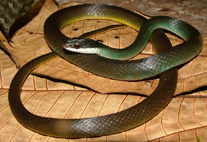Abstract
The present study is a taxonomic revision of the genus Drymoluber Amaral, 1930, using meristic and morphometric characters, aspects of external hemipenial morphology and body coloration. Sexual dimorphism occurs in D. dichrous and D. brazili but was not detected in D. apurimacensis. Morphological variation within D. dichrous is related to geographic distance between populations. Furthermore, variation in the number of ventrals and subcaudals in D. dichrous and D. brazili follows latitudinal and longitudinal clinal patterns. Drymoluber dichrous is diagnosed by the presence of 15-15-15 smooth dorsal scale rows with two apical pits, and 157–180 ventrals and 86–110 subcaudals; it occurs along the eastern versant of the Andes, in the Amazon forest, on the Guiana Shield, in the Atlantic forest, and its transitional areas with the Caatinga and Cerrado. Drymoluber brazili has 17-17-15 smooth dorsal scale rows with two apical pits, 182–202 ventrals and 109–127 subcaudals, and ranges throughout the Caatinga, Cerrado, Atlantic forest and transitional areas between these last two domains. Drymoluber apurimacensis has 13-13-13 smooth dorsal scale rows without apical pits, 158–182 ventrals and 84–93 subcaudals, and occurs in the Apurímac Valley, south of the Apurímac and Pampas rivers in Peru.

